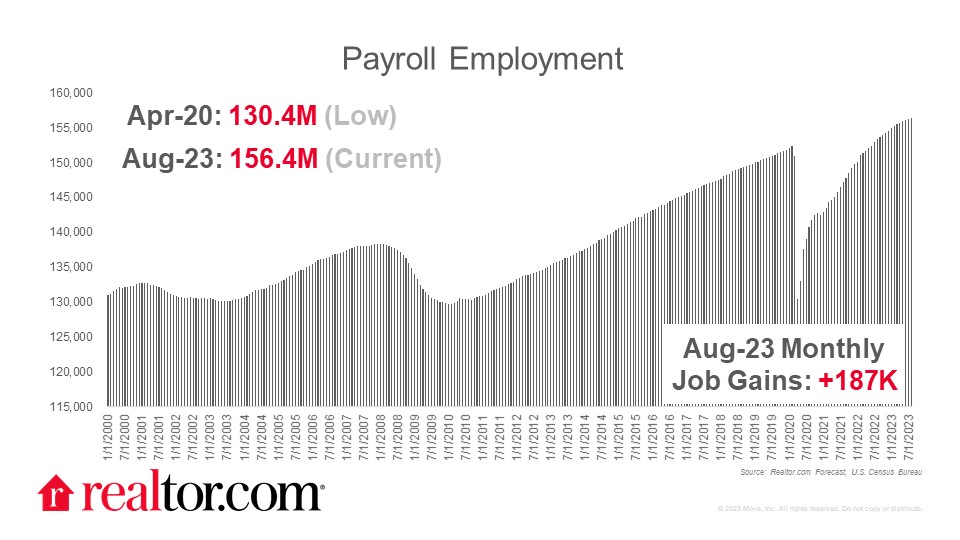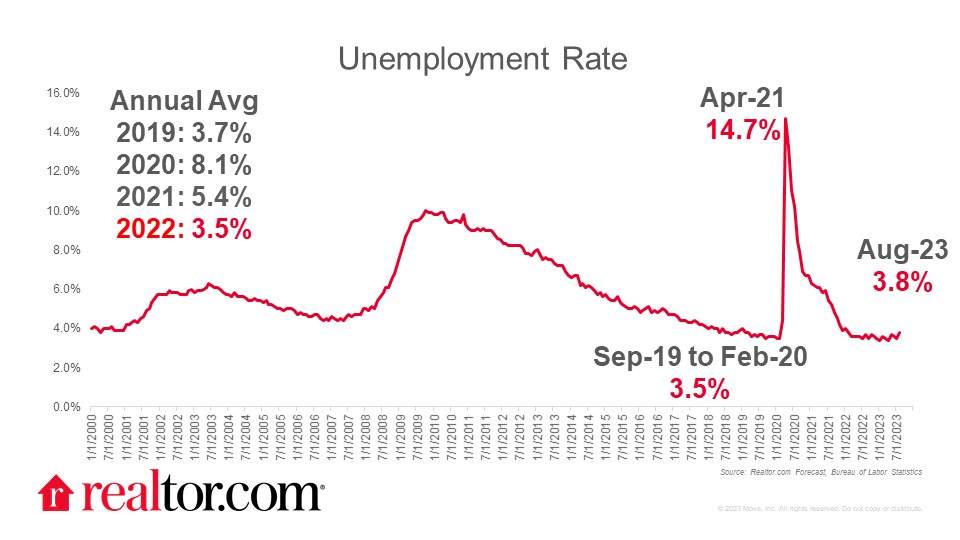The September jobs report, which was published on time since the government shutdown was averted, contrasted markedly with recent private hiring data. The report showed that hiring surged by 336,000 in September, well above the 267,000 monthly average for the previous 12 months. In contrast with August, data for the prior two months was also revised higher. Unemployment held steady at 3.8% after a sharper uptick in August. Job gains were spread across various industries including leisure and hospitality; government; professional, scientific, and technical services; and social assistance. Today’s report is likely to add further fuel to the trends driving interest rates, including mortgage rates, higher.
In August, job openings reversed their recent trend, climbing back to 9.6 million from 8.9 million in July. Nevertheless, job openings were down nearly 20% from their March 2022 high (12 million), dropping the openings rate from a peak of 7.4% to 5.8% in August. At the same time, job quits held steady at 3.6 million or 2.3%, slightly below peak rates seen in both 2001 and 2019 and below the surge in quits seen since the beginning of 2021. Put another way, the job openings and labor turnover data (JOLTS) offered mixed signals on the details of labor churn in August and whether the market is improving or steady, but it is unquestionably still a favorable environment for workers.
There are still more jobs than out-of-work job seekers (1.5). Although the ratio is down from its peak of 2 in early 2022, it remains well above the 1.2 level it occupied from mid-2018 to early 2020. The number of unemployed workers was unchanged at 6.4 million in September. Average hourly earnings for private employees rose by 4.2% in the last year, a small tick down from 4.3% last month. Although hourly wage growth continued cooling, it remains elevated.
At the September Fed meeting, the committee did not raise rates, but their updated economic projections, which indicated that the short-term policy rate would likely remain higher for longer, may have finally convinced markets that the Fed was not bluffing when it reaffirmed its commitment to whatever is needed to bring inflation back to 2%. Since that meeting, investors have rapidly repositioned themselves to prepare for that reality, which likely means higher rates for longer. This has driven up long-term rates, including mortgage rates, to levels not seen since 2000, and created the paradoxical stage of the economic cycle when better than expected data is actually bad news because it means even higher rates. Today’s reading shows that the labor market remains on surprisingly firm footing and is likely to feed into recent trends pushing interest rates, including mortgage rates, higher.
While long-term high mortgage rates remain a significant challenge for homebuyers that are unlikely to recede quickly, we are at the point in the year when predictable seasonal trends in the market create a bit of a break for homebuyers. The first week of October offers shoppers who need to move now a dip in price relative to summer’s peak, more homes for sale than the typical week in a year, and less competition. Despite these breaks, the macro trends remain daunting. The number of homes for sale continues to slide as many homeowners are content to stay put and enjoy their current mortgage rates which are, in many cases, half as high as today’s home purchasers face. Amid affordability challenges, many households trying to decide whether to buy or rent are likely to settle on renting as the monthly costs of buying a starter home are lower than renting in just 3 of the 50 major metro markets. With a significant amount of rental housing supply currently under construction, this financial advantage of renting is likely to continue. Nevertheless, households trying to evaluate their options will want to look not only at today’s costs, but costs over time. A tool, like this Rent v. Buy calculator at Realtor.com, can help consumers evaluate whether it makes sense to wade into the purchase market at a challenging time or continue to rent.”
Subscribe to our mailing list to receive updates on the latest data and research.
Join our mailing list to receive the latest data and research.
U.S. Job Growth Surges in September with 336000 New Jobs – Realtor.com News

(Visited 1 times, 1 visits today)


